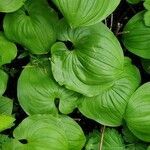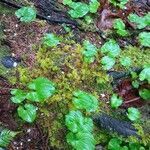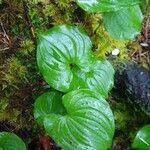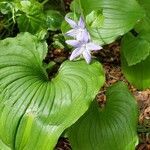Plants terrestrial, 20–45 cm. Rhizomes sympodial, proliferatively branching, units 8–20 cm × 1–1.5 mm, roots restricted to nodes. Stems erect, 1.5–3.5 dm × 2–4 mm. Leaves solitary on sterile shoots, 2–3 on fertile shoots, petiolate; blade cordate, 6–10 × 5–8 cm; base lobed, with deep sinus; apex sharply acute; proximal leaves short-petiolate, blade triangular to cordate, petiole 4–7 cm; distal leaves petiolate, blade deeply cordate, petiole 7–10 cm. Inflorescences racemose, complex, 15–40-flowered. Flowers (1–)3(–4) per node, 2-merous; tepals conspicuous, 2–3.2 × 1.5 mm; filaments 1.5 mm; anthers 0.2–0.4 mm; ovary globose, 0.8–1 mm wide; style 0.4–0.5 mm; stigma distinctly 2-lobed; pedicel 3–5 × 0.2–0.4 mm. Berries green mottled with red when young, maturing to deep translucent red, globose, 4–6 mm diam. Seeds 1–2, globose, 2–3 mm. 2n = 36.
More
A low plant that keeps growing from year to year. The rhizome or underground stem is slender and branching. The stems are 10-25 cm tall. There are usually one leaf near the base and two near the top. The leaves are broad, smooth and heart shaped. The flowers are small and white. The flowers are in a cluster at the top of the plant. The fruit are round berries.
Shaded or moist streambanks and open to dense coniferous and broadleaved woods if they are moist, especially favouring woodland margins, growing in humus-rich slightly acid soils; at elevations up to 1,000 metres.
More
It is a temperate plant. It grows in moist, shaded woods and swampy areas.




